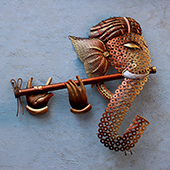Design Resource
Wrought Iron Craft - Nagpur, Maharashtra
Traditional Metal Craft
by
Prof. Bibhudutta Baraland Srikanth B.
Iron is the fourth most abundant element on earth, occupying more than 5% of the earth’s crust. Obtained from iron ore, it is formed naturally in sedimentary rocks. Iron ore, also known as ironstone, holds varying amounts of other elements as well such as silicon, sulfur, manganese, and phosphorus. Wrought iron derived from iron alloy is a soft, ductile, and fibrous variety suitable for forging or rolling rather than casting due to its low carbon content. The word ‘wrought’ is a past participle of the verb ‘to work’ and hence wrought iron stands for ‘worked iron’. During the 17th to 19th century, wrought iron was known in various names based on its forms, origin, and its quality, while in the 20th century, it was set to use for building decorative items like iron railings, doors, balconies, grilles, and other exterior fittings.
Wrought usually contains less than 0.1 percent carbon and 1 to 2 percent slag, hence favorable for most purposes than cast iron, which is overly brittle owing to its high carbon content. Wrought iron is manufactured by the puddling of cast iron. This involves heating cast iron and manually mixing air in with the molten mass. The process of smelting iron from its oxides in a furnace is called the Bloomery process. Here bloomery is the name for the equipment or a type of furnace used to treat the iron. In this process, cast iron is heated with charcoal on a one-to-one ratio. At this point, enough air is blown in through a nozzle to heat the elements to a temperature somewhat below the melting point of iron. Adding charcoal fosters to reduce the ore to iron, with the help of carbon monoxide formed in the reaction, which eventually separates iron and slag. This gives bloom, a spongy byproduct made of mixed iron and slag. This attained bloom is then again heated to be beaten with a hammer to drive out slag. This is an important step as the raw bloom is highly porous, and its open spaces are heavily filled with slag. These steps are repeated multiple times until it holds the least percent of carbon and slag. Iron treated this way is called wrought iron or bar iron. The wrought iron usually contains around 0.02% to 0.08% carbon, thus making the metal stronger and malleable.
Decorative items made out of wrought iron are in great demand nationally as well as at international markets; hence there are many manufacturers and laborers across the country putting in hard efforts to create this absolute masterpiece. One such manufacturer is New Handicrafts from Nagpur, started by Mr. Nitesh and Mr. Santosh in 2010. With the backing of 25 skilled artisans, the company is a leading entity in the manufacturing, wholesale, and supply of antique metal statues and various types of traditional and contemporary wall hangings.






